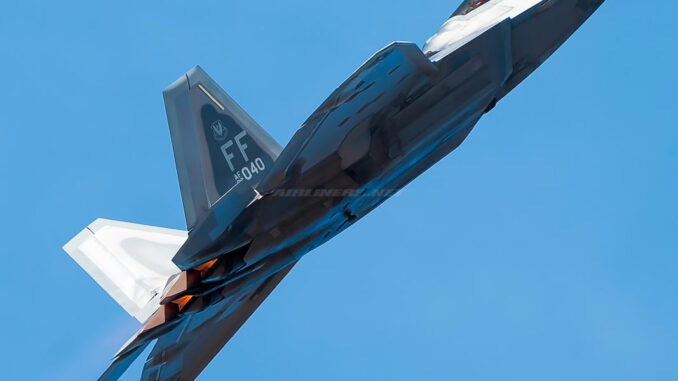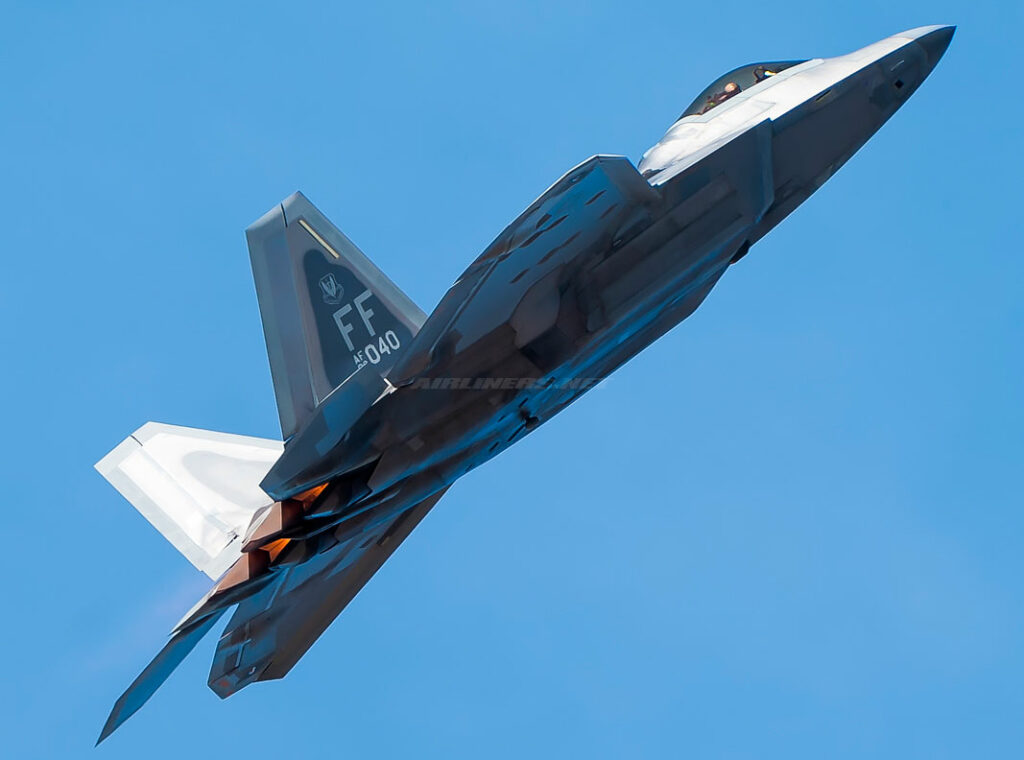
Detailed analysis of the F-22 Raptor’s strategies for countering long-wave radars.
The F-22 Raptor, the jewel in the crown of American fighter aircraft, embodies the pinnacle of aerial stealth. Designed to evade conventional radars, it now faces a growing threat: long-wave radars. These systems, operating in VHF and UHF bands, challenge the invisibility of stealth aircraft. This article explores the techniques used by the F-22 to maintain its discretion in the face of these radars.
The stealth design of the F-22 Raptor
The F-22 Raptor was designed with meticulous attention to reducing its radar signature. Its airframe has carefully designed angles to deflect radar waves, while absorbent materials dissipate them. The S-shaped air intakes mask the internal components, thus reducing radar reflections. In addition, the armament is integrated into internal bunkers, avoiding any disturbance of the smooth surface of the aircraft. These characteristics give the F-22 an estimated radar cross-section (RCS) of 0.0001 m² in certain configurations, equivalent to that of a steel ball.
However, this stealth is mainly effective against high-frequency radars. Long-wave radars, due to their longer wavelength, are less sensitive to traditional stealth techniques. The F-22 must therefore resort to additional strategies to maintain its discretion against these systems.

Long-wave radars: a growing threat
Long-wave radars, operating in the VHF (30 to 300 MHz) and UHF (300 MHz to 1 GHz) bands, are characterized by a wavelength of between 1 meter and 10 meters, which radically changes their interaction with stealth aircraft. Unlike X-band (8–12 GHz) or Ku-band (12–18 GHz) radars, which are widely used for missile tracking or terminal guidance, VHF/UHF radars do not seek millimeter precision. Their objective is early detection over long distances, particularly in contested areas or in electronic saturation.
The radar absorbing materials (RAM) that cover stealth aircraft such as the F-22 Raptor are mainly optimized for high frequencies. They work by dielectric absorption or phase cancellation at wavelengths of less than 10 centimeters. In VHF, the wavelengths exceed the absorption capacities of the RAM, which makes their efficiency marginal. At these frequencies, the entire aircraft acts as a resonator, and no longer as a reduced diffuser. This means that radar reflection is no longer induced only by surface details (edges, angles, antennas), but by the overall volume of the cell.
Long-wave radars also benefit from Mie resonance phenomena, which appear when the size of an object becomes comparable to the incident wavelength. In this case, even a stealth-optimized cell generates a detectable return signal. Simulations show that an aircraft such as the F-22 can achieve an effective radar cross-section (RCS) of 0.1 to 1 m² in VHF, compared to 0.0001 m² in X band, which represents a multiplier factor of 1,000 to 10,000.
Another technical factor is the diffraction effect around structures such as wings and stabilizers. In VHF, the waves diffract more around these elements, which prevents their complete concealment even with an optimized design. Internal bunkers, tapered edges and sloping shapes have only a marginal effect at these frequencies.
Military powers such as Russia (Nebo-M, 55Zh6UME radars) and China (JY-27A) are investing heavily in this technology. The Nebo-M, for example, combines several radar bands (VHF, L and X) on an integrated platform. In VHF, it can detect a stealth aircraft at more than 350 km, with an azimuthal uncertainty of approximately 0.5° to 1°, i.e. an absolute position error of 3 to 6 km at this distance. This does not allow a target to be engaged directly, but provides an “initial warning” that feeds higher frequency radar systems for location and engagement.
Modern long-wave radars are often coupled with high-performance computers that use multistatic analysis, sensor fusion, and radar echo correlation on distributed detection networks. The processing makes it possible to identify weak but repetitive correlations, typical of a stealth aircraft on approach. In addition, contemporary systems such as the Russian Container (29B6), a bistatic VHF over-the-horizon radar, extend the detection range to 3,000 km, with airspace coverage even before a stealth fighter approaches the borders.
Even if these radars remain imprecise for terminal guidance, their strategic role is crucial. They impose a tactical cost on the adversary: flying lower, cutting off emissions, or resorting to complex maneuvers. This reduces the operational effectiveness of stealth aircraft and weakens the initial advantage they had over integrated defense systems.

The F-22’s countermeasures against long-wave radars
To deal with the resurgence of long-wave radars, the F-22 Raptor cannot rely solely on its stealth design. Threat management involves a combination of advanced electronic warfare, specific flight tactics and electromagnetic emission management. These countermeasures are designed to disrupt the detection chain without offering the enemy a clear point of fixation.
The core of the F-22 defensive system is based on the AN/ALR-94 electronic warfare system, considered one of the most sophisticated currently in service. It includes more than 30 antennas distributed over the airframe, capable of detecting a VHF or UHF band radar emission up to 480 kilometers, depending on the angle of approach and the power emitted. This system does not just pick up signals: it analyzes their nature, modulation and direction, enabling the pilot or the automated system to decide on the appropriate response.
When the F-22 is exposed to a long-range VHF radar, it can trigger directional jamming, targeted at the opposing transmission beam, rather than flooding the area with interference. This jamming relies on controlled emissions in the enemy frequency band to disrupt the synchronization of radar pulses. This directional jamming reduces the exposure of the F-22 while avoiding revealing its own position to other sensors.
In addition, the F-22 has active decoys (e.g. ALE-55 or NGJ-A) that can simulate a larger radar signature at a distance from the actual aircraft. This decoy, whether launched or towed, emits a reflected signal that draws long-range radars or surface-to-air missiles to a false position. This technique is particularly useful against coherent pulse radars, used for the detection of low RCS targets.
In terms of kinematics, the F-22 fully exploits its super-cruising and maneuvering capabilities to minimize the duration of exposure to a radar beam. At high speed (Mach 1.5 without afterburner) and medium altitude, it can cross a VHF radar detection zone in less than two minutes, making it difficult for the opposing command systems to merge the detection data. In contested environments, it is also capable of descending to 150–300 meters altitude and using terrain masking (ridge line flying) to slip away from the main lobes of long-range radars.
The F-22 also applies a strict policy of electromagnetic spectrum management: the radar emissions of its AN/APG-77 AESA are modulated, encrypted and ephemeral. It can operate in LPI (Low Probability of Intercept) mode, which prevents enemy passive radars from detecting its radar emissions. On offensive missions, the Raptor prefers to use its passive sensors (ESM, RWR, on-board or shared IRST via datalink) to avoid announcing its presence electronically.
Finally, inter-platform coordination via secure data links (Intra-Flight Datalink, IFDL) allows tactical information to be shared between several F-22s, or even with other platforms such as the E-3 Sentry or F-35. This allows certain aircraft to fly in total radar silence while benefiting from the information of a “detector” aircraft, whether it is behind or at a higher altitude.
In short, the F-22 Raptor does not seek to “make itself invisible” to long-wave radars – which, technically, remains unlikely – but to render any detection unusable or too late to allow coordinated engagement. Its architecture is based on a combination of passive stealth, active jamming and tactics to saturate the opposing processing. This gives it a clear advantage in the early stages of a confrontation, but does not guarantee long-term immunity to the continuous evolution of multiband radar systems.
The F-22 Raptor remains a formidable stealth fighter, but the emergence of sophisticated long-wave radars poses new challenges. To maintain its superiority, it must combine advanced stealth technologies, effective electronic countermeasures and adapted flight tactics. The constant evolution of threats requires continuous adaptation of stealth strategies to guarantee air dominance.
War Wings Daily is an independant magazine.